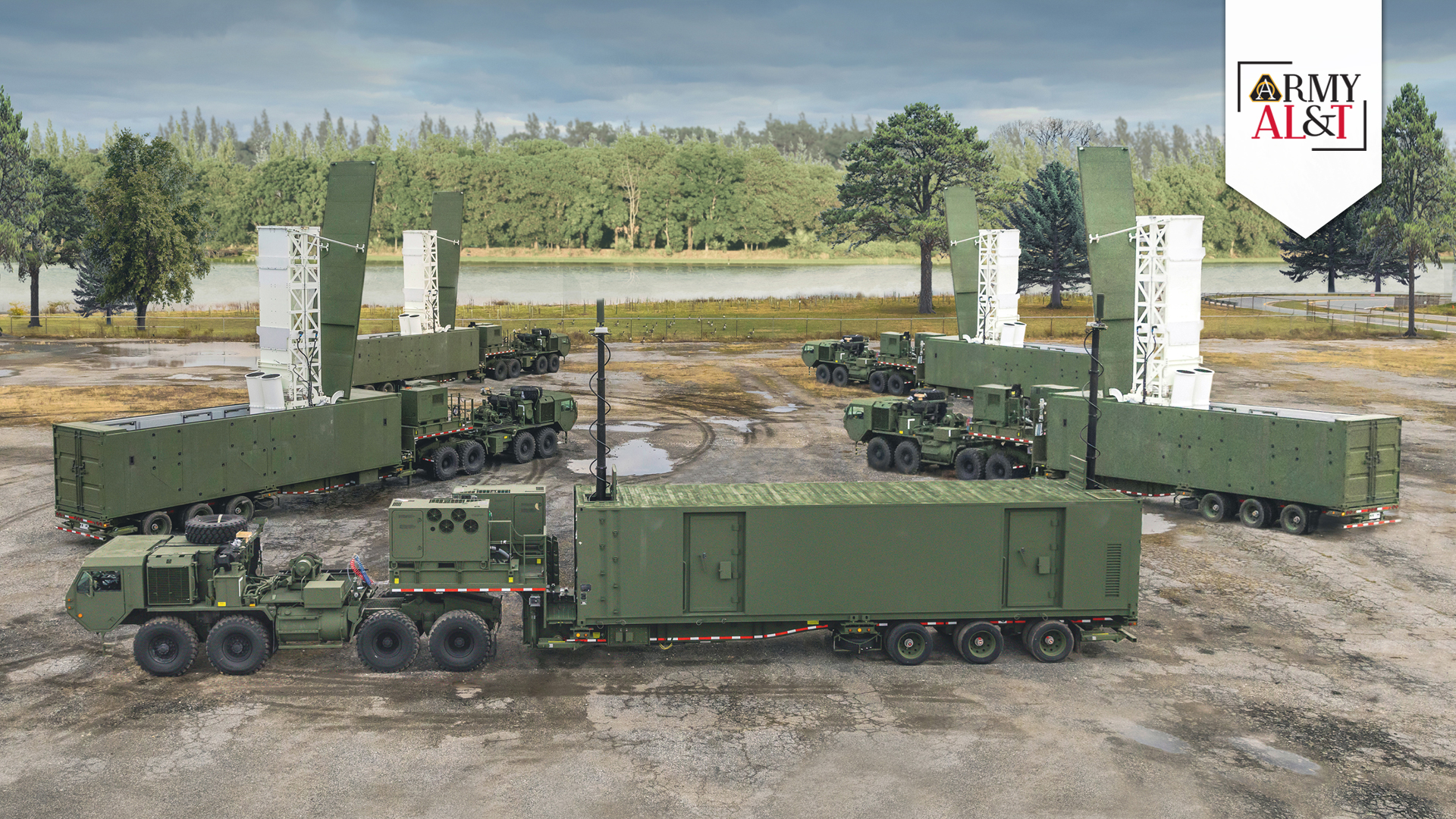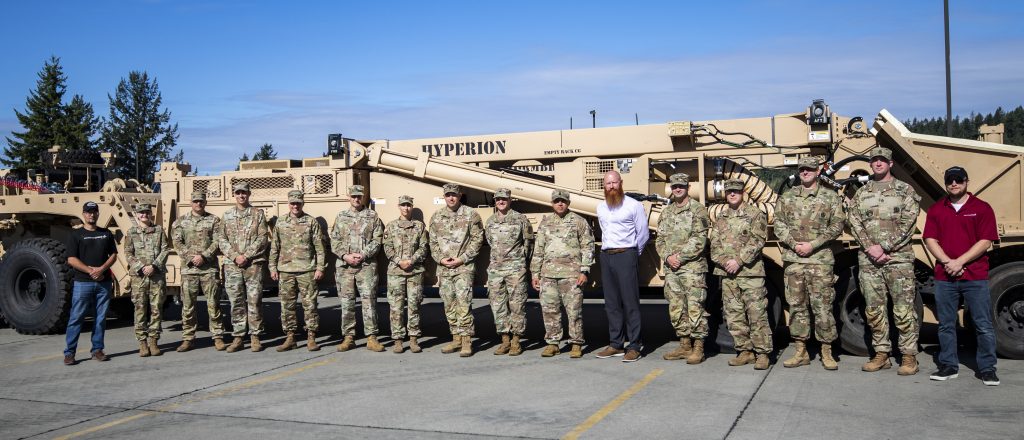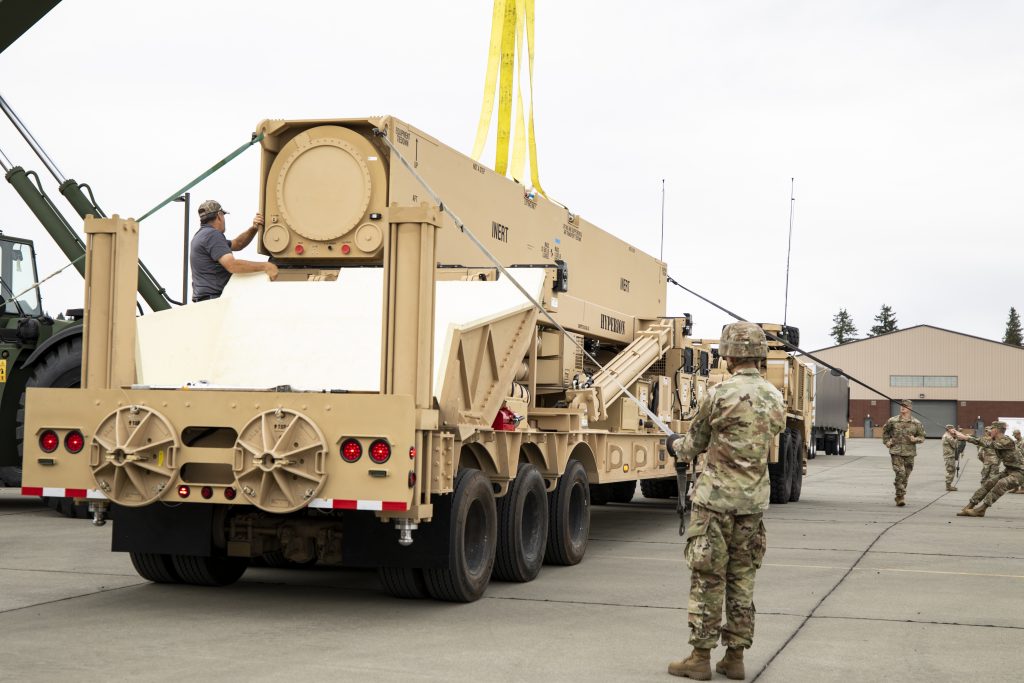
PROGRAM REASSIGNMENT: The Army has reassigned primary responsibility of the MRC from the RCCTO to PEO MS. The MRC provides a land-based, ground-launched system supporting multidomain fires against specific threats. (Photo courtesy of Darrell Ames, PEO MS)
Two new missile programs deliver enhanced capabilities to thwart emerging threats and bolster joint force effectiveness.
by Cheryl Marino
Missiles play a crucial role in modern warfare, continually evolving with technological advancements and shaping military strategies worldwide. From this ever-changing landscape, two new groundbreaking missile programs have emerged, promising to redefine military capabilities and strategies with cutting-edge technology.
The Army’s Long-Range Hypersonic Weapon (LRHW) and Mid-Range Capability (MRC) programs were designed to enhance the military’s rapid response capabilities, allowing for swift and flexible deployment to address emerging threats while contributing to interoperability among different branches of the military and allied forces.
Initially developed by Lockheed Martin Corp. for the Army’s Rapid Capabilities and Critical Technologies Office (RCCTO), these programs are expected to fully transition to the Program Executive Office for Missiles and Space’s (PEO MS) Task Force for Strategic Integrated Kinetic Effects (STRIKE) in fiscal year 2025 for additional, long-term development, modernization and sustainment.
While both the LRHW and MRC are ground-launched systems that provide advanced capabilities to engage targets effectively across different ranges, they operate differently. The LRHW system enables rapid and precise strikes against time-sensitive or heavily defended targets at hypersonic speeds over long distances. The MRC system delivers accurate strikes against a variety of targets within intermediate distances.
“LRHW and MRC are complimentary weapon systems, filling gaps in the Army’s long range precision fires portfolio,” said James Mills, deputy director for the Army’s Hypersonic Project Office at RCCTO. “Both systems provide extended ranges that support the Army’s multidomain operations.”

TOMAHAWK TAKE-OFF: In June 2023, RCCTO’s MRC Project Office, in conjunction with Soldiers from the 1st Multi-Domain Task Force and the Navy’s Program Executive Office for Unmanned Aviation and Strike Weapons, successfully demonstrated the launch of a Tomahawk missile from the Army’s prototype MRC system. (Photo courtesy of Darrell Ames, PEO MS)
FUELING THE LONG-RANGE NEED
The Army has prioritized the LRHW modernization portfolio in support of the National Defense Strategy to provide combatant commanders with diverse capabilities for battlefield dominance at a multitude of ranges and to address the critical need for U.S. hypersonic capabilities across domains and platforms to effectively engage high-value targets and disrupt the ability of potential adversaries to anticipate and respond to attacks. LRHW does not replace an existing Army or DOD weapon. It is a new class of weapon for the Army and DOD and is the nation’s first operational hypersonic weapon, with a total of three LRHW batteries planned for delivery.
“The responsiveness and survivability of hypersonic weapons is unmatched by traditional ballistic capabilities for precision targeting, especially in anti-access/area denial environments,” said Lt. Gen. Robert A. Rasch, director of Hypersonics, Directed Energy, Space and Rapid Acquisitions for RCCTO. Rasch testified March 12, 2024, at a House Armed Services Committee hearing where policies, programs and priorities associated with U.S. hypersonic capabilities and intent of adversaries’ hypersonic development efforts were addressed.
Anti-access/area denial (A2/AD) aims at preventing an adversary from entering or operating freely within a specific area, typically a region of strategic interest. It involves the deployment of ground-based missile systems, artillery and other assets to protect key locations, deny access to enemy forces and create a layered defense against potential threats.
The RCCTO was chartered in April 2019 as part of the Army’s Modernization Strategy, to spearhead developing, prototyping and delivering emerging technological capabilities on an accelerated timeline to combat units for operational experimentation.
In 2020, the LRHW Abbreviated-Capability Development Document (A-CDD)—used to establish the Army’s requirement for development of a materiel capability—was validated by Army Futures Command. This A-CDD confirmed the need and provided the source for desired capabilities to execute rapid experimentation and prototyping efforts.
“Upon the decision to embark on the development of these systems, the services, government labs and industry rallied together with remarkable speed to build out a commercial industrial base to meet combatant commander requirements,” said Col. Patrick D. Farrell, project manager for MRC and Task Force STRIKE lead.

SPECIAL DELIVERY: The delivery of the first prototype hypersonic hardware to Soldiers of the 5th Battalion, 3rd Field Artillery Regiment, 17th Field Artillery Brigade was completed in October 2021 and marked by a ceremony at Joint Base Lewis-McChord, Washington. (Photo by Spc. Karleshia Gater, I Corps)
PUTTING THE LONG IN LONG-RANGE
The LRHW is a road-mobile and air-transportable weapon system, armed with missiles that can travel at speeds in excess of 3,800 miles per hour, with a reported range of 1,725 miles. It communicates with the Army’s command and control networks via the Advanced Field Artillery Tactical Data System.
The LRHW system consists of Army ground support equipment—one battery operations center (BOC), four transporter erector launchers, a BOC support vehicle and up to eight All-Up Rounds plus Canister. The LRHW leverages a Navy-designed missile (a two-stage booster and the Common Hypersonic Glide Body (CHGB)) packaged in an Army canister.
The system “can reach the top of the Earth’s atmosphere and remain just beyond the range of air and missile defense systems until they are ready to strike and by then it’s too late to react,” according to Army statements in a March 2023 Congressional Research Service report. The report further noted that the missile component of the LRHW, developed by Lockheed Martin and Northrop Grumman Corp., can be fired from surface vessels and submarines.
“The term ‘hypersonic weapon’ is often confusing,” Farrell said. “Technically, a weapon is hypersonic if it travels faster than five times the speed of sound. But by this measure, nearly all ballistic missiles going back to World War II are hypersonic.” The real difference with today’s hypersonic weapons, he said, is that they combine multiple features that in the aggregate make them very hard to shoot down. Speed, maneuverability (unpredictability) and flight at relatively low altitudes (as compared to ballistic missiles) make modern hypersonic weapons survivable and more likely to reach the intended target.
The Army and Navy are closely partnered and the Navy’s Conventional Prompt Strike program and Army’s LRHW program share development efforts and resources. “The Navy leads the design of the CHGB, while the Army leads its production,” Farrell said. “Previous hypersonic technology development has largely resided only within government labs, but recently has significantly transitioned to industry.”
The CHGB is based on the Alternate Re-Entry System developed by the Army and Sandia National Laboratories. Currently, Leidos Dynetics is under contract to produce CHGB prototypes for the Army and Navy. According to the congressional report, “The CHGB uses a booster rocket motor to accelerate to well above hypersonic speeds and then jettisons the expended rocket booster. The CHGB, which can travel at Mach 5 or higher on its own, is planned to be maneuverable, potentially making it more difficult to detect and intercept.”
“Hypersonic weapons solve the problem of survivability to target,” Farrell said. “Ultimately, hypersonics provide a combination of speed, maneuverability and a flight profile enabling survivable, long-range, rapid defeat of time-critical, heavily defended and high value targets.”
|
TWO TYPES OF HYPERSONIC WEAPONS There are two basic types of hypersonic weapons: hypersonic cruise missiles and boost-glide weapons. LRHW is a boost-glide weapon. A hypersonic cruise missile is normally launched from an aircraft and uses an air-breathing engine for thrust all the way to the target. In contrast, a boost-glide hypersonic weapon uses a missile booster stack to carry a hypersonic glide body above the atmosphere. The glide body is then released to follow a ballistic (arcing) trajectory until it enters the atmosphere, at which point it generates lift and levels out to glide at hypersonic speeds over a long distance to the target. Part of the Army’s Long Range Fires Battalion in support of multidomain operations, LRHW is the Army’s contribution to joint hypersonic efforts to counter peer and near-peer adversary development and deployment of A2/AD strategies. |
POWERING THROUGH CHALLENGES
Accelerated programs like LRHW inevitably face hurdles, potentially leading to technical and logistical challenges. While testing may be limited, proactive mitigation and adaptive strategies can offset setbacks, foster innovation and drive the program toward success.
According to Farrell, the LRHW program is executing an Army-directed development timeline that is much more aggressive than what is normally applied to weapon system development programs. In 2019, the system was originally planned to be delivered within five years from initiation. However, unexpected snags prompted an extension. “Even with delays to work through these challenges, the current timeline is still faster than the normal 10- to 15-year development timeline,” he said. “The target delivery for residual combat capability is [calendar year] 2024.”
The Army planned for three flight tests of the LRHW before the first battery fielding in fiscal year 2023. In October 2021, the booster rocket carrying the CHGB vehicle reportedly failed a test flight, resulting in what defense officials characterized as a “no-test” because the CHGB had no chance to deploy. A June 2022 test of the entire LRHW missile also resulted in a no-test. In October 2022, DOD delayed a scheduled LRHW test to assess the root cause of the June 2022 no-test.
“Challenges were realized in several joint flight test attempts in 2023,” Farrell said. “The Army and Navy teams worked with industry as quickly as possible to take the necessary corrective actions and return to the range for further testing.” Analysis and ground test activities are underway to mitigate risks associated with flight test events.
Currently, Farrell said, the LRHW is in the final stages of flight tests designed to collect required data, demonstrate capability and validate the system’s design. Following a successful end-to-end flight test, RCCTO will deliver the first LRHW missile and transition the LRHW capability to PEO MS, where the program will continue flight testing and further development.
According to a January/February 2022 Arms Control Association article, the Cost Assessment and Program Evaluation Office within the Office of the Secretary of Defense estimated that the Army’s LRHW program will cost $4.4 billion for development and $2.5 billion for production. With a plan for 66 missiles, including 48 tactical missiles, the cost of each LRHW missile comes to $106 million.

FASTER THAN THE SPEED OF SOUND: Hypersonic weapons, capable of flying at speeds greater than five times the speed of sound, are a new capability that provides a unique combination of speed, maneuverability and altitude to defeat time-critical, heavily defended and high-value targets. (Photo by Spc. Karleshia Gater, I Corps)
FILLING THE MID-RANGE GAP
While the LRHW incorporates a new missile, new launcher design and a new command and control design, the MRC takes two existing Navy missiles, normally fired from ships and submarines, and hosts them inside a road-mobile launch platform. A modified version of the Navy’s Vertical Launching System is housed within a 40-foot container on the trailer, allowing the Army to launch both types of Navy missiles—the Standard Missile 6 (SM-6) and the Tomahawk Land Attack Missile—from land, with MRC focusing on the ranges between the Precision Strike Missile (PrSM) and LRHW.
With the dissolution of the Intermediate-Range Nuclear Forces treaty in 2019, which prohibited all U.S. and Soviet missiles with ranges between 500 and 5,500 kilometers, DOD and the Army began weighing options to fill the range gap. The RCCTO initiated the Mid-Range Capability program in July 2020, in response to the Army’s 2020 Strategic Fires Study, which indicated the need for a fires capability at ranges between PrSM, which has a range of roughly 300 miles, and LRHW to engage adversary moving maritime, high-payoff and A2/AD threats in support of multidomain operations.
The Army determined that using existing Navy missiles was the fastest way to meet this operational need (as stated in the fiscal year 2020 Strategic Fires Study). The SM-6 (a fast, multipurpose missile) and the Tomahawk Land Attack Missile (a slower, low-flying cruise missile with longer range) were selected as most suitable for engaging the targets required by the Army. The Army also leveraged other existing capabilities, such as the ability to fire a Tomahawk from a trailer-mounted platform, to develop the MRC launch system. Through a number of iterative designs, this capability matured to what the Army adopted as its initial starting point for the MRC program.
“The MRC rapidly progressed from a blank piece of paper in July 2020, to the Soldiers’ hands in just over two years. The RCCTO team, as well as our joint service and industry partners, delivered this hardware so Soldiers can begin training as quickly as possible,” Rasch said in December 2022 in a Lockheed Martin press release.
PROGRESS THROUGH PARTNERSHIP
The MRC battery is a road-mobile, air transportable system composed of four launchers, a battery operations center and other support vehicles. The trailer-mounted containerized launcher incorporates a modified version of the Navy’s Mk-41 Vertical Launching System, controlled by a BOC that hosts the Aegis Weapons System and Tactical Tomahawk Weapon Control System, the command and control systems necessary to launch either munition.
According to a December 2022 Congressional Research Service report, the MRC weapon system leverages existing SM-6 and Tomahawk cruise missiles, both produced by Raytheon Co., as is.
“These weapons control systems are also common with the Navy, which greatly expedited the development process,” Farrell said. “By adopting these systems, the Army gained decades of capability and knowledge from the Navy through the shared partnership in developing this system.”
Through partnerships with the Navy, the Office of the Secretary of Defense and Lockheed Martin as the MRC prime contractor, the capability was developed and fabricated in record time and delivered to the unit in December 2022.
“Following new equipment training, the gaining unit at Joint Base Lewis-McChord supported two successful flight test events demonstrating the system and unit’s readiness to support operations,” Farrell said. “Following munitions delivery, the MRC reached its full operational status, and the unit is currently supporting operational exercises, exercising the hardware and networks needed to conduct these missions.”
By using existing Navy munitions, the Army inherits the capabilities provided by these missiles. “Future variants of both the SM-6 and Tomahawk will provide greater range, speed and the ability to prosecute a wider range of targets with great effect,” Farrell said. “The Army and Navy have linked destinies, both wanting these missiles as soon as possible to meet operational needs. This requires consistent progress, funding and support to ensure these enhanced capabilities are developed and produced on time to meet operational needs.”
The missiles are housed at a government-owned facility and MRC munitions are currently maintained by the Navy at key sites worldwide. Because the MRC can be deployed around the world, MRC munitions storage will ultimately support operational demands where needed.
The MRC program is a fully funded, $629 million program that expects to deliver a total of five batteries to the operational force. The Army’s system uses several common components with the Navy as well as the Navy’s munitions.
“By purchasing these with the Navy, economies of scale can be achieved, supporting both service’s bottom lines,” said Maj. Brendan Georgas, MRC assistant product manager.
The first battery of MRC capability is currently in the field as part of the Army’s 1st Multi-Domain Task Force, which is gaining experience training on and employing the system in operational environments. The MRC program continues to produce and enhance capabilities of additional batteries that will be used around the world as needed to ensure freedom of movement for U.S. and allied forces.
“With MRC as part of the joint force, the Army will provide combatant commanders the ability to shape the battlespace in contested areas from the land,” Farrell said.
CONCLUSION
The Army’s advancements of its LRHW and MRC weapon systems mark significant milestones in modern warfare technology. These systems offer unparalleled speed, range and precision, bolstering the Army’s capacity to deter and swiftly respond to emerging threats.
Looking ahead, sustained investment in research, development and deployment will be imperative to fully harness the potential of these technologies. Fostering international collaboration and strategic planning will be vital to seamlessly integrate these capabilities into broader defense strategies.
As these systems continue to evolve, they have the potential to fundamentally reshape the dynamics of military engagements, underscoring the importance of responsible and strategic use in preserving global stability and security.
For more information, go to https://www.army.mil/peoms.
CHERYL MARINO provides contract support to the U.S. Army Acquisition Support Center (USAASC) at Fort Belvoir, Virginia, as a writer and editor for Army AL&T magazine and Network Runners Inc. Before joining USAASC, she served as a technical report editor at the U.S. Army Combat Capabilities Development Command Center at Picatinny Arsenal, New Jersey, for five years. She holds a B.A. in communications from Seton Hall University and has more than 20 years of writing and editing experience in both the government and private sectors.







